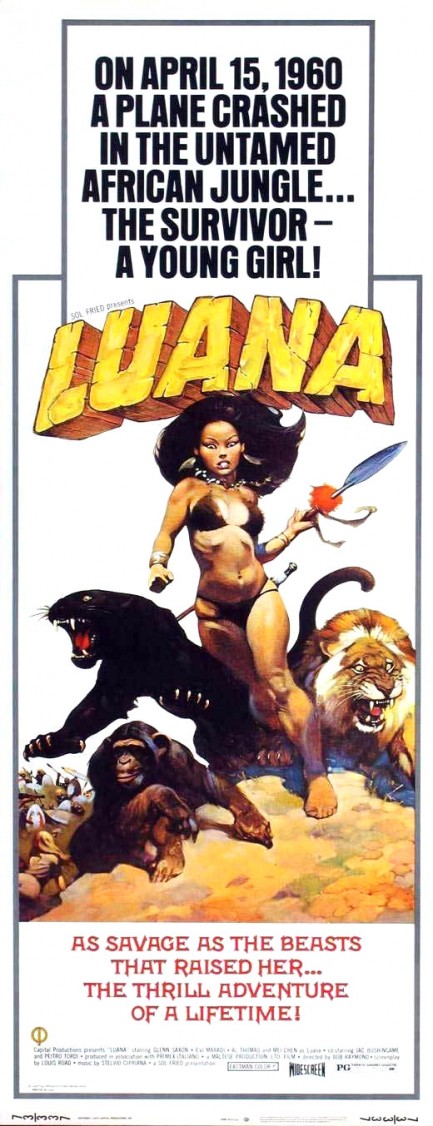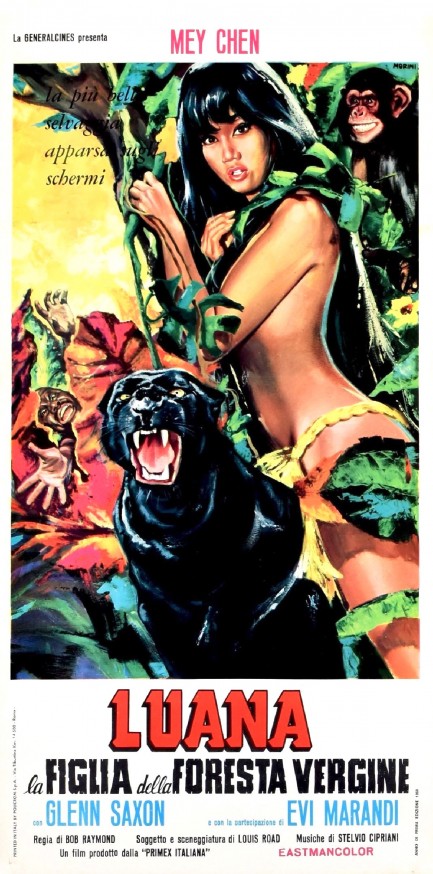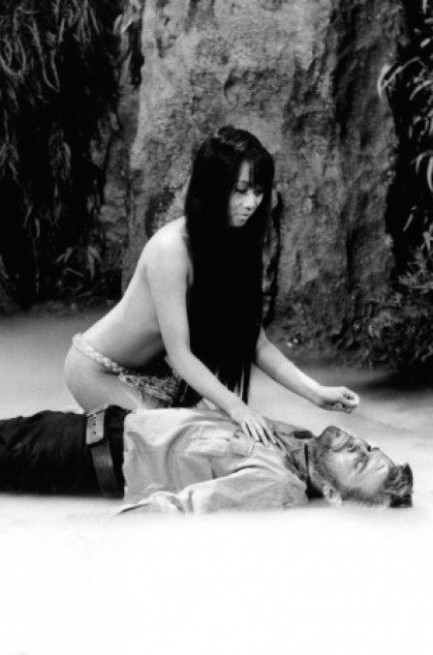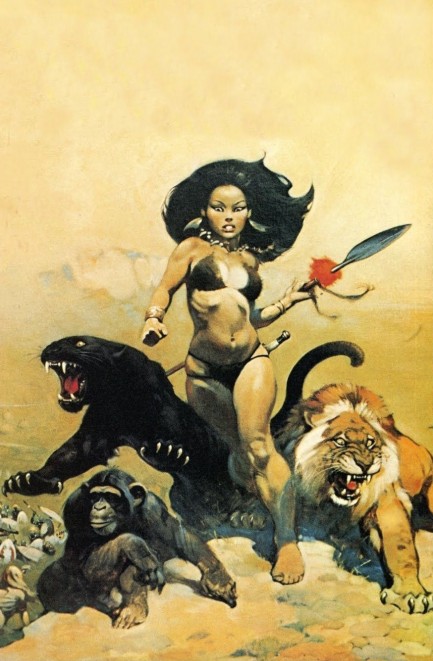 Her Majesty the Queen of the Jungle is unavailable—she's gone hunting today. 
Several years ago we talked about the lost world adventure Luana la figlia delle foresta vergine and showed you its Italian poster. Today we're showing you the much cooler U.S. promo, which was painted by Frank Frazetta, one of the kings of fantasy art. His work was used for numerous promos, but this is one of our favorites. It wasn't made specifically for the movie. It was adapted from one of his many earlier pieces, below. You can see a little more Frazetta here, as well as here, where we talked about the novelization of the movie.
 She's tougher than Tarzan, meaner than Sheena, and lustier than Gungala. 
You can look at this cover and correctly assume that we've shared it because it was painted by Frank Frazetta, considered by many to be the master of sword and sorcery art. It's a beautiful piece, rightly famous. Alan Dean Foster is a master too. He isn't what you'd call a significant author in the sense that he's produced lauded original material, but he may be the king of movie novelizations. Among his output: The Black Hole, Clash of the Titans, Outland, Starman, Pale Rider, and The Chronicles of Riddick, as well as novelized series based on Star Wars, Star Trek, and Alien. We love Foster for his Star Wars sequel Splinter of the Mind's Eye, which came out before The Empire Strikes Back (notice we don't bother with that Episode nonsense) and followed Luke and Leia—not siblings in Foster's universe—as they adventured on strange worlds and discovered their love for each other. We still think the film series should have followed Foster's lead, but whatever.
His Luana is a novelization of the 1968 movie of the same name starring Mei Chen Chalais, which we talked about a while back. Sometimes novelizations are published before the film, sometimes after. Foster published Luana six years after the film in 1974 for reasons that are obscure. It was among his first published books. While template for a novelization is provided by the filmmakers, the author is who gives it color and life. Foster fulfills that duty with obvious relish, mining literary and cinematic antecedents like Tarzan, Tarzana, Gungala, Sheena, Shuna, and Ka-Zar for familiar tropes. A kilometer long pit filled with army ants? A lion and panther, both larger than any ever seen before, working in tandem with a huge chimp? A pitched battle between blowgun wielding Tanzanian tribesmen and an expedition of white explorers? A secret city of solid gold buildings? As lost world tales go, by standing on the shoulders of his predecessors, Foster crafts something better than average. And far better than the movie too.
 My designer told me it would be a daring dress but this is a little ridiculous. 
Vietnamese actress Mei Chen, aka Mei Chen Chalais, tries on a dress and immediately realizes her designer got her request for a plunging neckline confused. Chen isn't well known today, but she'll always have a place in our hearts for her lost world film Luana. And this crazy dress. The photo is from 1968 and first appeared in the magazine Girl Illustrated.
 It don't mean a thing if it ain't got that swing. 
One good swing deserves another, and since we screened Tarzana, sesso selvaggio, we thought we'd check out another Italian female Tarzan movie, 1968's Luana la figlia della foresta vergine. Basically, a man who disappeared into the African jungle many years ago is sought by the daughter he left back in civilization. The father had taken a second wife who bore him a second daughter. Unbeknownst to the first daughter, her father and his new wife died, and the second daughter grew up in the jungle alone, befriended by birds, primates, and an assortment of big cats. So the first daughter leads a jungle expedition and ends up stumbling upon a half sister that spends her time swinging on vines from water hole to water hole.
Describing the premise of this movie was probably more trouble than it was worth. All we really needed to say is that it's a film that features hot French actress actress Evi Mirandi and hot Vietnamese actress Mey Chen, aka Mei Chen Chalais, who has no lines at all but looks great running around in a loincloth. She also knows the jungle well enough to avoid the carnivorous flowers, something that—crucially—can't be said of others. The rest is unimportant. The poster art above is interesting, we think. It's signed, illegibly, and nobody has yet determined who the artist was. Someone in Italy needs to work that out. We'll just wait here trying to decide whether Luana la figlia della foresta vergine was actually any good. It premiered today in 1968.
  
|
 |

The headlines that mattered yesteryear.
2003—Hope Dies
Film legend Bob Hope dies of pneumonia two months after celebrating his 100th birthday. 1945—Churchill Given the Sack
In spite of admiring Winston Churchill as a great wartime leader, Britons elect
Clement Attlee the nation's new prime minister in a sweeping victory for the Labour Party over the Conservatives. 1952—Evita Peron Dies
Eva Duarte de Peron, aka Evita, wife of the president of the Argentine Republic, dies from cancer at age 33. Evita had brought the working classes into a position of political power never witnessed before, but was hated by the nation's powerful military class. She is lain to rest in Milan, Italy in a secret grave under a nun's name, but is eventually returned to Argentina for reburial beside her husband in 1974. 1943—Mussolini Calls It Quits
Italian dictator Benito Mussolini steps down as head of the armed forces and the government. It soon becomes clear that Il Duce did not relinquish power voluntarily, but was forced to resign after former Fascist colleagues turned against him. He is later installed by Germany as leader of the Italian Social Republic in the north of the country, but is killed by partisans in 1945.
|

|
|

It's easy. We have an uploader that makes it a snap. Use it to submit your art, text, header, and subhead. Your post can be funny, serious, or anything in between, as long as it's vintage pulp. You'll get a byline and experience the fleeting pride of free authorship. We'll edit your post for typos, but the rest is up to you. Click here to give us your best shot.

|
|
















































































